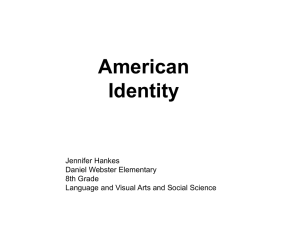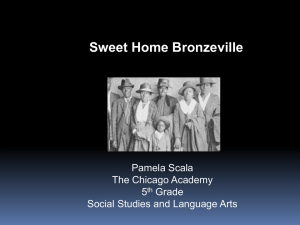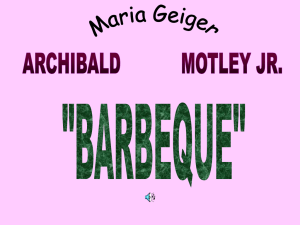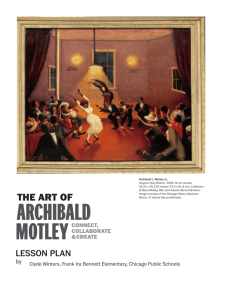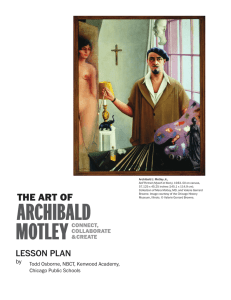Document 14343445
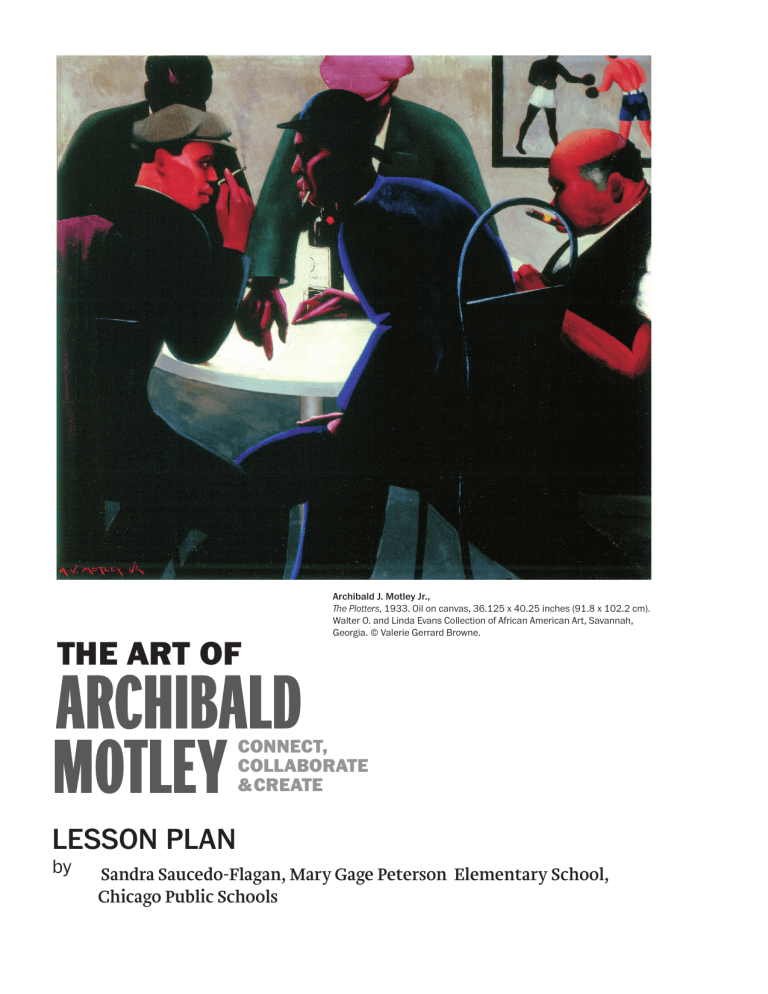
Archibald J. Motley Jr.,
The Plotters , 1933. Oil on canvas, 36.125 x 40.25 inches (91.8 x 102.2 cm).
Walter O. and Linda Evans Collection of African American Art, Savannah,
Georgia. © Valerie Gerrard Browne.
THE ART OF
ARCHIBALD
MOTLEY CONNECT,
COLLABORATE
& CREATE:
LESSON PLAN
by
Sandra Saucedo-Flagan, Mary Gage Peterson Elementary School,
Chicago Public Schools
Summary of lesson plan
In this unit for 4th grade language arts, students will study different people of past and modern history that are known to be “revolutionaries.” The term “revolutionary” follows Merriam Webster’s definition as someone who “participated in or brought about a major or fundamental change.” As students study various worldly figures, they will answer the question,
“What makes this person a revolutionary?” Using text references and their own inferences based on what information they have gathered, students will be able to answer this question. Students will also explore the big idea of perseverance; namely how the revolutionaries overcome conflict and stay true to their convictions.
Big Idea
• A theme is a message that the author/artist wants readers/viewers to understand about people, life, and the world in which we live.
• Authors/Artists make decisions about topics in order to communicate ideas and experiences.
• Perseverance has many qualities including fear, hard work, discipline, commitments, failure, and passion.
Interpretations of a text involve linking information across parts of a text and determining importance of the information presented.
• References from texts provide evidence to support conclusions drawn about the message, the information presented, and/or the author’s/artist’s perspective.
Enduring Questions
• How do writers/artists communicate a theme?
• How does the comparison of themes from various pieces of literature/media increase understanding?
• How do we persevere and what makes certain individuals persevere more than others?
• What are the characteristics of a revolutionary?
Learning Objectives
Key Knowledge-Students will know how to…
• Identify a theme and topic
• Compare and connect to similar themes and topics
• Analyze an author’s/artist’s use of the theme
Key Skills-Students will be able to…
• Make inferences based on what a character learns or what message the author/artist is sending to the reader
• Create a piece of artwork connected to specific themes the author/artist wants to express
• Analyze how a theme in a piece of artwork is expressed through the elements of color, objects, and composition
Standard
RL. 4.1
RL.4.2
RL .4.7
W.4.4: Produce clear and coherent writing in which the development and organization are appropriate to task, purpose, and audience.
(Grade-specific expectations for writing types are defined in standards 1–3 above.)
Common Core State Standards
Refer to details and examples in a text when explaining what the text says explicitly and when drawing inferences from the text.
Determine a theme of a story, drama, or poem from details in the text; summarize the text.
Make connections between the text of a story or drama and a visual or oral presentation of the text, identifying where each version reflects specific descriptions and directions in the text.
Objective-Students will . . .
Make inferences based on what a character learns or what message the author is sending to the reader.
Identify theme and topic.
Analyze how a theme in a piece of work is expressed through the elements of design?
Analyze author’s/artist’s use of the theme.
Compare and connect to similar themes and topics.
Write an expository paragraph describing the theme of a piece of art work by using inferences and text references.
Visual Arts 27B: Students who meet the standard understand how the arts shape and reflect history, society and everyday life.
Create a piece of art work connected to themes.
Lesson Plan Activities
Length: This lesson is a 6-day lesson or it can also be used as a stand- alone lesson.
Materials/Supplies for the Lesson:
•
•
•
•
•
•
•
•
•
• Activity 3: Think, pair, share and close read of Archibald J. Motley, Jr., Por-
trait of a Cultured Lady, 1948
• Exit slip question: What message is Motley trying to convey about the “Cultured Lady”? Explain your answer using details from the artwork, text, and your own knowledge.
Day Two:
• Activity 1: Whole class “Category” close read of Archibald J. Motley, Jr.’s
Black Belt, 1934
• (See attached for close read guided questions.)
• Activity 2: Pair reading of information sheet about The Chicago Black
Renaissance.
• sessment of Black Belt.
•
Whole group share out and reas-
(See attached for Info Sheet.)
•
(1929)
•
Slides of artwork
Student friendly artist biography
Student friendly handout about
The Chicago Black Renaissance
Oil pastels
Construction paper
Notebook paper
Pencils
Chart paper
Markers
Activity 3: Think, pair, share close read of Archibald J. Motley, Jr., Blues
Exit slip question: What theme or message is Motley trying to convey about the “Black Belt” and how does this make
Motley a revolutionary? Explain your answer using details from the artwork, text, and your own knowledge.
• Activity 4: Whole class “Share
Out:” What made Motley a revolutionary? Complete on chart paper and post.
Day Three:
• Activity 1: Teacher “Read Aloud” and discussion of “We Real Cool” and “Of
DeWitt Williams on His Way to Lincoln
Cemetery” by Gwendolyn Brooks
(See attached for poems)
Review the information about the •
Chicago “Black Belt” before close read of
Motley’s painting, The Plotters (1933).
• Read Joe Louis, America’s Fighter by David Adler to add significance to the artist’s decision to include a depiction of boxers on the wall in The Plotters.
Day One:
•
•
Activity 1: Warm Up
In this unit, student will study different people of past and modern history that are known to be “revolutionaries.”
Motley is the focus of our Art Revolutionary. How was Motley a revolutionary?
• Whole class close reading of Archibald J. Motley, Jr. Self-Portrait, c. 1920
• (See attached for close read guided questions.)
• Activity 2: Pair reading of Motley biography
• Whole group share out and reassessment of Self-Portrait.
• phy.)
(See attached for Motley biogra-
•
•
Activity 2: Whole class “close read” of Archibald J. Motley, Jr. The Plot-
ters, 1933.
(See attached for close read guided questions.)
• Activity 3: Four Corners Cooperative Learning Activity, this cooperating learning activity promotes discussion and student engagement. There are many ways to implement Four Corners, but the goal in using this strategy is to allow students to record different perspectives to lead into thoughtful discussion.
(See attached for Four Corners Directions)
• Exit Slip: “Motley is conveying the theme of perseverance. What details in the painting help Motley get his message across?”
Day Four and Five:
•
The student will then write a short explanation paragraph.
Day 6:
Students will explore the idea of showcasing himself or herself as a revolutionary. Students will create a piece of art using images of objects to relay the theme to the viewer that he or she is a revolutionary.
• Like Archibald Motley Jr., students will use color, lines, forms, and composition to help convey a theme.
•
• Students will showcase their work in a gallery walk, where other students will have a chance to close read each other’s work. Students will have their one paragraph explaining his or her work for other students to compare and contrast with their own close reads.
Assessments:
Evidence will include examples of exit slips and notes taken during discussions and close reads. Photographs of students engaged in small groups and cooperative learning groups will also be part of the documentation, as will photographs of final projects and explanation paragraphs.
(D) Diagnostic: In my class, students’ have already learned how to apply the close read (The close read refers to a “looking, analyzing, investigating, interpret, and synthesizing”) a piece of art through questioning. As advocated by the Terra Teacher
Labs, it helps “students think about and draw meaning from works of art” and to look for evidence to support their conclusions. Students also have learned how to identify and explore theme.
(F) Formative: – the check for understanding mechanisms used throughout the unit to ensure each student gets the instruction needed to be successful on the summative performance assessment.
Examples: reader’s notebooks, post-it jots, small group anecdotal records, discussion, drafts.
Students will work in cooperative learning small groups. Students will have discussions regarding the subject. Students will complete exit slips after each activity.
All images will be projected on a screen and a color copy will be provided to each group.
• Day One: Exit Slip: What message is Motley trying to convey through his painting A Cultured Lady (1948)? Explain your answer using details from the artwork, text, and your own knowledge.
• Day Two: Exit Slip: What theme or message is Motley trying to convey about the Black Belt and how does this make
Motley a revolutionary? Explain your answer using details from the artwork, text, and your own knowledge.
• Day Three: Exit Slip: “Motley is conveying the theme of perseverance.
What details in the painting help Motley get his message across?”
• Exits slips will be evaluated for content to assess student understanding, inferences/conclusions and participation.
(S) Summative – the “summary of student’s achievement in relation to…learning standards.”
Students will create a piece of art that expresses a self-selected theme. Following the model of Archibald Motley, students will select and include color, lines, forms, and composition to express their theme.
The students will then write a short paragraph explaining their theme and how the visual elements relate to it.
Works of Art
Archibald J. Motley Jr., The Plotters,
1933. Oil on canvas, 36.125 x 40.25 inches (91.8 x 102.2 cm). Walter O. and Linda Evans Collection of African
American Art, Savannah, Georgia.
Archibald J. Motley Jr., Black Belt,
1934. Oil on canvas, 33 x 40.5 inches
(83.8 x 102.9 cm). Collection of the Hampton University Museum,
Hampton, Virginia
Archibald J. Motley, Jr., Portrait of a
Cultured Lady, 1948. Oil on canvas,
39.5 x 32 inches (100.3 x 81.3 cm)
Courtesy of Michael Rosenfeld Gallery, LLC, New York, New York
Key information about the artist:
Archibald John Motley (1891–1981) was born in New Orleans and moved with his parents to Chicago when he was an infant. At a very young age he knew that he wanted to be an artist. He was an African American painter. He studied painting at the School of the
Art Institute of Chicago, graduating in 1918. He became the second African American artist to have a solo exhibition in New York City.
He was also the first African American to have a painting of another African American subject exhibited in the Art Institute of Chicago. He is most famous for his colorful painting showing the African-American experience in the 1920s and 1930s. According to the artist, he wanted to depict African American subjects as he “felt them within himself.” Given that few artists during this era focused on depictions of African Americans, Motley truly was a revolutionary painter.
Key information about the artist’s context:
Motley’s efforts reflect the changing attitudes toward race during the Black Chicago Renaissance. According to the Chicago Metro
History Education Center Black Chicago Renaissance, “Chicago experienced a new surge of African American creativity, activism and scholarship began to flower in the South Side Chicago district then becoming known as “ Bronzeville .” This new “ Chicago Renaissance ” was fueled by two unprecedented social and economic conditions: the “ great migration ” of Southern blacks to Chicago in search of economic opportunity and perceived security from lynch mob rule and the crisis of the Great Depression that followed.”
Key information about Plotters:
In Plotters, we see a group of men gathered around a table. They are focused on each other and seem to lean in as if discussing something of great importance. Smoking and drinking were among the pleasures that men could enjoy in bars and clubs along the South Side neighborhood called “The
Stroll.” On the wall behind them is a painting depicting two boxers; one black and the other white. Perhaps this is a reference to Jack Johnson, the first African American heavy-weight boxing world champion whose defeat of James Jefferies sparked racial riots in 1910. More than just a “revolutionary” rendering of black urban life, this painting show Motley’s innovative compositional techniques. He compresses space, repeats forms, and interconnects his figures in a way that is truly modern.
List of resources for teachers and students:
• “Archibald Motley, Artist of African American Life.” African American Registry. NADA Global. Web. 18 Jan. 2015.
<http://www.aaregistry.org/historic_events/view/archibald-motley-artist-african-american-life>.
• “Archibald Motley, Jr., Painter.” Area of Design. Web. 18 Jan. 2015. <http://www.areaofdesign.com/ americanicons/motley.htm>.
• Flug, Michael. “Black Chicago Renaissance.” Chicago Metro History Education Center. Chicago Metropolitan
History Fair. Web. 18 Jan. 2015. <http://www.chicagohistoryfair.org/for-teachers/curriculum/black-chicagorenaissance.html.
• Gomez, Edward M. “Archibald J. Motley, Jr.’s Paintings: Modern Art Shaped by Precision, Candor, and Soul.”
Hyperallergic, Sensitive to the Arts and Its Discontents. 9 Mar. 2014. Web. 18 Jan. 2015. <http://hyperallergic.com/113198/archibald-j-motley-jr-s-paintings-modern-art-shaped-by-precision-candor-and-soul/>.
• “The Harlem Renaissance; Archibald Motley, Jr.” African American World. PBS, NPR. Web. 18 Jan. 2015. <http:// www.pbs.org/wnet/aaworld/arts/motley.html>.
• Mooney, Amy M. “Representing Race: Disjunctures in the Work of Archibald J. Motley Jr.” (Art Institute of
Chicago Museum Studies, Vol. 24, No 2, 1999).
• Mooney, Amy M. Archibald J. Motley Jr. The David C. Driskell (Series of African American Art: Volume
IV. (Pomegranate Publishing, San Francisco, 2004).
• Powell, Richard J., ed. Archibald Motley: Jazz Age Modernist. Durham: Nasher Museum of Art at Duke U,
2014. Print.
Acknowledgments:
This lesson plan is the result of a series of professional teacher development workshops initiated by hosted by Columbia College Chicago and Chicago’s Department of Cultural Affairs and Special Events for the exhibition Archibald Motley: Jazz Age Modern-
ist. The exhibition was organized by the Nasher Museum of Art at Duke University. Grant support to the Chicago Department of Cultural Affairs and Special Events provided by the Nasher Museum of Art at Duke University and the Terra Foundation for
American Art. Support to the Nasher Museum of Art at Duke University provided by the Terra Foundation for American Art; the National Endowment for the Humanities: Exploring the human endeavor; and the Henry Luce Foundation; and the Wyeth
Foundation for American Art. The educational collaboration was facilitated through Columbia’s Department of Education, Art +
Design, the Center for Community Arts Partnership and the Dean’s Office for the School of Fine and Performing Arts. Additional support and planning was contributed by Chicago Public Schools, Chicago Public Library, Carter Woodson Branch and the
Chicago Metro History Project. Contributing individuals for the Chicago initiative include: Anne Becker, Beverly Cook, Susan Friehl,
Michael Flug, Lynne Green, Amy Mooney, Cecil McDonald, Jr., Sadira Muhammad, Lisa Oppenheim, Daniel Schulman, Jennifer
Siegenthaler, and Ray Yang.
Appendix-Lesson Plan Handouts
Archibald Motley, Jr.:
Revolutionary Close Read Guided Questions
Day One: Whole Class Close Read of Archibald J. Motley, Jr.
Self-Portrait, c. 1920
Teacher begins: Take a minute to study this image and list in writing the details you notice; afterward we’ll have a discussion.
Guided Questions:
• So what did you see? What’s going on in the image/ work of art?
• What is something you notice about the colors?
• What is something you notice about the objects?
• What is something you notice about the person in the piece?
• What did you notice first and why?
• What’s the focal point?
• How does the artist show us what’s important?
• How does your eye travel through the picture, and why?
• Notice the artist’s use of lines (or colors, shapes, etc.).
• What adjectives would you use to describe the lines
(colors, shapes, etc.)?
• What’s the overall mood of the painting?
• Who is the person in the piece?
• What’s his job?
• What’s his social status?
• How do you know? What in the painting tell you this?
• What do you think the artist wanted to communicate?
• What do you see that makes you say that?
• What’s the main idea or the theme of this piece?
Share out and chart on large paper or board. Then move to 2 nd activity; read Motley Biography. After reading, regroups and reassess 1 st close read and discuss. Move onto 3 rd activity.
Day Two: Whole Class “Category” Close Read of Archibald J.
Motley, Jr. Black Belt, c. 1934
Teacher begins with having students fold the paper into 4 compartments. Label the compartments, “Background,” “Foreground,” “Mid-ground,” “I wonders…”.
Teacher instructs students to, “Take a minute to study this image and list in writing the details you notice into the different categories; afterward we’ll have a discussion.
Use the guided questions as the students write their answers in the categories. Background is the part of the picture that is farthest to the viewer, foreground is the part of the picture that is nearest to the viewer, mid-ground is the part of the picture that seems to be in the midrange from the viewer or middle of the picture. They should write questions or wonderings they have about the whole picture in the “I wonder…” category.
• So what did you see? What’s going on in the image/ work of art?
• What is something you notice about the colors?
• What is something you notice about the objects?
• What is something you notice about the people in the piece?
• What did you notice first and why?
• What’s the focal point?
• How does the artist show us what’s important?
• How does your eye travel through the picture, and why?
• Notice the artist’s use of lines (or colors, shapes, etc.).
• What adjectives would you use to describe the lines
(colors, shapes, etc.)?
• What’s the overall mood of the painting?
• Who are the people in the piece?
• Where are they going?
• What are they doing out?
• What are their social statuses?
• How do you know? What in the painting tell you this?
• What do you think the artist wanted to communicate?
• What do you see that makes you say that?
• What’s the main idea or the theme of this piece?
Share out and chart on large paper or board. Then move to 2 nd activity; read The Black Chicago Renaissance.
After reading, regroups and reassess 1 st close read and discuss.
Move onto 3 rd activity.
Day Three: Whole Class Close Read of Archibald J. Motley, Jr. The
Plotters, 1933
• So what did you see? What’s going on in the image/ work of art?
• What is something you notice about the colors?
• What is something you notice about the objects?
• What is something you notice about the people in the piece?
• What did you notice first and why?
• What’s the focal point?
• How does the artist show us what’s important?
• How does your eye travel through the picture, and why?
• Notice the artist’s use of lines (or colors, shapes, etc.).
• What adjectives would you use to describe the lines
(colors, shapes, etc.)?
• What’s the overall mood of the painting?
• Who are the people in the piece?
• Where are they?
• What are they doing?
• What are they talking about?
• What are their social statuses?
• How do you know? What in the painting tell you this?
• What do you think the artist wanted to communicate?
• What do you see that makes you say that?
• What’s the main idea or the theme of this piece?
There is no group share out on day three. Students move straight into 4 Corners Activity.
Modified “Four Corners” Activity:
Four Corners is a cooperating learning activity that promotes discussion and student engagement. There are many ways to implement Four Corners. The goal of this lesson’s implementation of the strategy is to allow students to record different perspectives to lead to thoughtful discussion for metacognition of the themes.
Materials needed: Chart Paper, markers, close read notes
Students will share out and discuss their close read of Archibald J. Motley, Jr. The Plotters, 1933.
Students have assigned roles to facilitate the discussion and organize participation.
Students will get into 4 corner groups of 4 to 5 students each. More corners may be needed if it’s a larger class.
Assigned Roles:
• Secretary: Writes notes on the chart paper.
• Group facilitator: Makes sure everyone has equal voice and say.
• Researchers: 2 students who will guide other students to go back into past text to support claims.
• Exit Slip facilitator: Student who will guide students to answer the exit slip question using supporting evidence.
Directions: Teacher will have students gather into corners to prepare to discuss close read. Teacher will assign roles once students are in their groups or corners.
First Step: Students will share out their notes taken during the close read. The secretary will record them on the chart papers as the group facilitator guides the discussion.
Second Step: The Exit Slip facilitator will present the question to the group and guide the students to come to a consensus with the researchers help support the claims made.
Third Step: Students will then share out exit slips in a whole group share out.
Day Three: Activity 1
We Real Cool
By Gwendolyn Brooks
SEVEN AT THE GOLDEN SHOVEL.
We real cool. We
Left school. We
Lurk late. We
Strike straight. We
Sing sin. We
Thin gin. We
Jazz June. We
Die soon.
THE POOL PLAYERS.
Poems by Gwendolyn Brooks of De Witt Williams on his way to Lincoln Cemetery
By Gwendolyn Brooks
He was born in Alabama.
He was bred in Illinois.
He was nothing but a
Plain black boy.
Swing low swing low sweet sweet chariot.
Nothing but a plain black boy.
Drive him past the Pool Hall.
Drive him past the Show.
Blind within his casket,
But maybe he will know.
Down through Forty-seventh Street:
Underneath the L,
And Northwest Corner, Prairie,
That he loved so well.
Don’t forget the Dance Halls—
Warwick and Savoy,
Where he picked his women, where
He drank his liquid joy.
Born in Alabama.
Bred in Illinois.
He was nothing but a
Plain black boy.
Swing low swing low sweet sweet chariot.
Nothing but a plain black boy.
Works Cited:
“Poet: Gwendolyn Brooks - All Poems of Gwendolyn Brooks.” PoemHunter.com. Web. 18 Jan. 2015.
<http://www.poemhunter.com/gwendolyn-brooks/>.
Archibald Motley Jr. Biography
Day One, Activity 2 Handout
Archibald John Motley, Jr. was born on October 7, 1891, in New Orleans, Louisiana. As a child, his family moved to Chicago, where his father worked as a Pullman Porter. Pullman porters were men hired to work on the railroads on sleeping cars to help passengers carry luggage and get them what they needed. Most porters were African-American. Growing up Motley actually witnesses his father and A. Phillip Randolph, a union leader; discuss organizing the Porter’s Union. “ The hard work and ambition that he witnessed as a child would carry him through his artistic career.” (African American Registry)
“He is considered one of the major contributors to The Chicago Black Renaissance and/or the New Negro Movement, a time in which
African American art reached new heights not just in New York but also across America.” (Area of Design) He specialized in portraiture depicting African American life in the city and African Americans in a positive viewpoint. Motley was very interested in showing the different skin-tones that make up the African American people. He felt that it was important to showcase African Americans in all of their possible identities. Motley is also famous for creating city scenes that focused on the African American community. He changed the way artist traditional depicted African Americans, usually in rural and humble scenes. He depicted these city scenes as an affluent and classy society that was rich in music and community.
Archibald Motley died on January 16, 1981 in Chicago, Illinois. His work is considered to be revolutionary as he worked to change how African Americans were depicted in American art and society. He worked in the African American communities and he wrote for newspapers such as The Chicago Defender promote this theme.
Works Cited:
“Archibald Motley, Artist of African American Life.” African American Registry. NADA Global. Web. 18 Jan. 2015. <http://www.aaregistry.org/historic_events/view/archibald-motley-artist-african-american-life>.
“Archibald Motley, Jr., Painter.” Area of Design. Web. 18 Jan. 2015. <http://www.areaofdesign.com/americanicons/motley.htm>.
“The Harlem Renaissance; Archibald Motley, Jr.” African American World. PBS, NPR. Web. 18 Jan. 2015. <http://www.pbs.org/wnet/ aaworld/arts/motley.html>.
Goal
Role
Audience
Situation
Project
Motley Summative Assessment
Your goal is create a self-portrait depicting yourself as a revolutionary.
Artist, subject, and revolutionary
Teacher, classmates, parents
A new gallery in town has invited future revolutionaries, like you, to exhibit a self-portrait. Your teacher, classmates, and parents are invited to attend this spectacular event.
You must create a self-portrait of yourself as a revolutionary. In the portrait you will use objects, colors, line, and form to express a theme of change. Remember a revolutionary is someone who has changed the world, the community, or industry in some form or another. What is something that you would like to see change in? Maybe it’s the environment, animal rights, human rights, sports, literature, art, medicine or something else that really draws you. Think of Archibald Motley,
Jr. and he was a revolutionary. How did he change the art world, his community, or even the world? How did he use his art to make a change? Take some ideas from Motley. Express these ideas of how you want to make an impact in your portrait. You must also write a one-paragraph explanation of your self-portrait. Use the rubric below to guide you.
Standards RL 4.1 Refer to details and examples in a text when explaining what the text says explicitly and when drawing inferences from the text.
W. 4.4 Produce clear and coherent writing in which the development and organization are appropriate to task, purpose, and audience. (Grade-specific expectations for writing types are defined in standards 1–3 above.)
Visual Arts 27B — Students who meet the standard understand how the arts shape and reflect history, society and everyday life.
Criteria
Subject
Theme of Revolutionary
Use of Color, Line, &
Form
Motley Summative Assessment Rubric
4
It is obviously a self-portrait. The subject is the focal point of the piece.
The theme of revolutionary is clearly and overwhelmingly expressed.
versa.
3
It is clear it’s a self-portrait but the subject is not necessarily the focal point of the piece, or vice
The theme of revolutionary is clearly expressed.
the piece.
2
It is unclear that it’s a self-portrait and the subject is not the focal point of
The theme of revolutionary is somewhat expressed.
1
It is not a self-portrait and there is no focal point of the piece.
The theme of revolutionary is not expressed.
The use of color, line, and form strongly adds to the theme of piece.
The use of color, line, and form clearly adds to the theme of piece.
The use of color, line, and form somewhat adds to the theme of piece but lacks effort or completion.
The use of color, line, and form does not add to the theme of piece, it lacks effort and/or is not complete.
Explanation Paragraph
The one-paragraph explanation of the piece explains the theme and use of color, line, form and objects used in the piece. It contains correct paragraph structure; topic sentence, body, and conclusion, grammar and spelling.
The one-paragraph explanation of the piece mostly explains the theme and use of color, line, form and objects used in the piece. It mostly contains correct paragraph structure; topic sentence, body, and conclusion, grammar and spelling.
The one-paragraph explanation of the piece somewhat explains the theme and use of color, line, form and objects used in the piece. It somewhat contains correct paragraph structure; topic sentence, body, and conclusion, grammar and spelling.
The one-paragraph explanation of the piece vaguely explains the theme and use of color, line, form and objects used in the piece. It barely contains correct paragraph structure; topic sentence, body, and conclusion, grammar and spelling.
The Black Chicago Renaissance Information Sheet
Day Two: Activity 2 Handout
• In the early 1930s, a second surge of African American creativity and activism began on the South Side Chicago in a neighborhood known as “ Bronzeville.”
• The Black Chicago Renaissance was influenced by two social and economic conditions: the Great Migration of
Southern blacks to Chicago in search of jobs and fleeing Jim Crow or segregation laws and the crisis of the Great
Depression.
• In a span of 20 years, the African American population in Chicago increased 5 times over. (44,000 in 1910 grew to more that 230,000) Most of population growth is attributed to new migrants.
• Housing was confined to small apartments in black only neighborhoods, which were not very nice, clean, or well kept.
• The migrants worked in meatpacking plants and steel mills, garment shops and private homes. After 1929, many people lost their jobs as the Great Depression hit the African American community hard.
• Due to unfairness in many of the areas of employment, labor unions began to form to advocate fair labor laws and treatment of workers.
• From 1932 through 1950, Chicago black community witnessed and participated in, developments in literature, in music, social science and journalism.
• Many African American artists, writers, musicians, journalists, and activists started to work toward the betterment of their community. Focusing on not only changing how African American acted and participated in society as a whole, also how the world viewed the African American community.
• There were libraries, community centers, churches, theaters and clubs that began to emerge in the community.
• Novels were at the center of the literature of the Chicago Renaissance. Writers published important novels dealing with slave revolts and the migration to the North. These were important themes to grow black history awareness during the period.
• Art was also very important to the movement. It was used as a way to show what was happening in the African
American communities of Chicago. Charles White, an African American artist, put it bluntly, “I feel that the job of everyone in the creative fields is to picture the whole social scene...Paint is the only weapon I have with which to fight what I resent. If I could talk I would talk about it. Since I paint, I must paint about it.” (Flug, 2015)
Works Cited:
Flug, Michael. “Black Chicago Renaissance.” Chicago Metro History Education Center. Chicago Metropolitan History Fair. Web. 18 Jan.
2015. <http://www.chicagohistoryfair.org/for-teachers/curriculum/black-chicago-renaissance.html.
“As summarized by Sandra Saucedo-Falagan”
